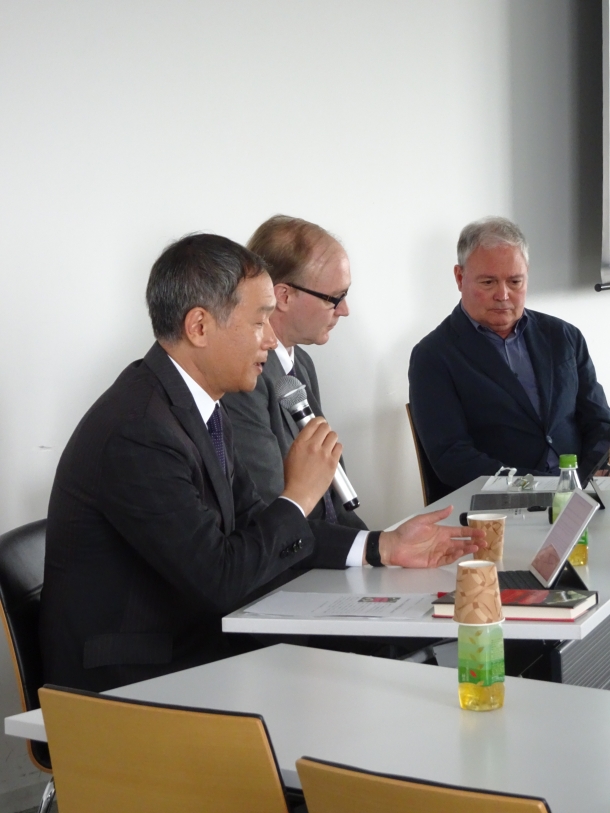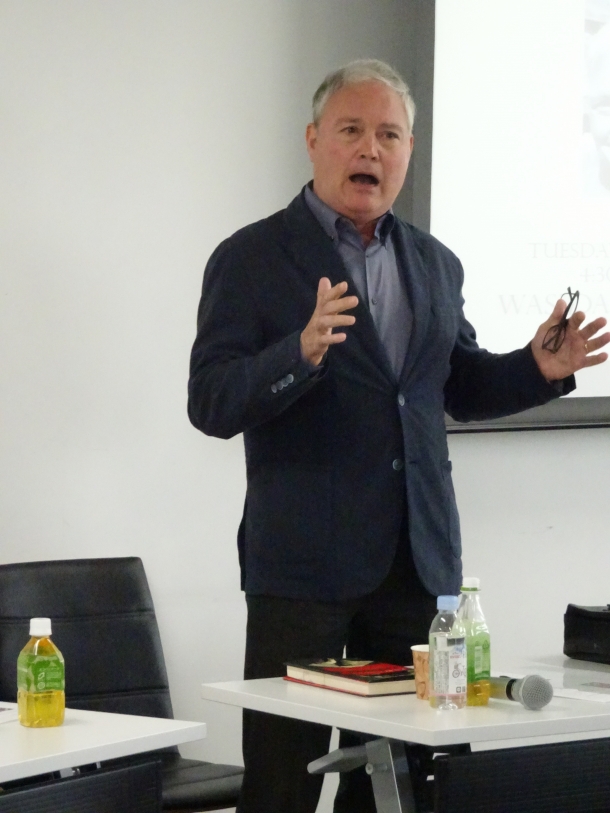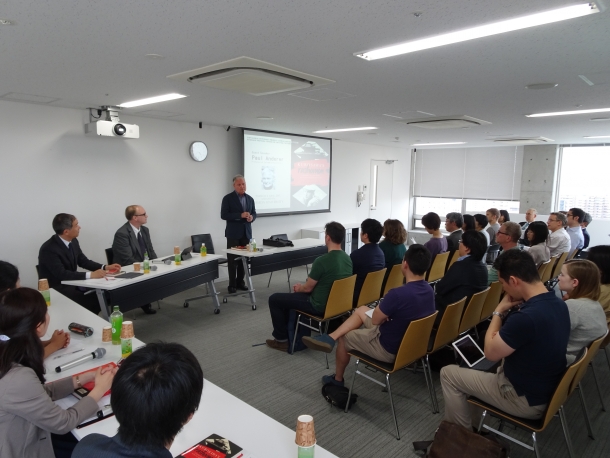A Lecture by Professor Paul Anderer (Columbia University)
『KUROSAWA’S rashomon』-Report-
June 6, 2017 (Tue.) 16:30〜18:00
Waseda University, Toyama Campus Bldg. 33, 16th floor, Meeting Room No.10
Host: Top Global University Project Global Japanese Studies
Ryusaku Tsunoda Center for Japanese Culture
Lecture: English; Q& A:English/Japanese
Commentator: Michael K. Bourdaghs (The University of Chicago, Professor)
Moderator: Hitomi Yoshio (Waseda University, Associate Professor)
Moderator: Younglong Kim (Waseda University, Guest Assistant Professor)
Closing remarks: Sungsi Lee (Waseda University, Professor)
Organizer: Hirokazu Toeda (Waseda University, Professor)
Coordinator: Hiroki Matsumoto (Waseda University, Guest Associate Professor)
This lecture was held at Waseda University on June 6, 2017 to celebrate the publication of Professor Paul Anderer’s KUROSAWA’S RASHOMON: A Vanished City, a Lost Brother, and the Voice Inside His Iconic Films (2016) and to offer an opportunity for attendees to see the professor speak in person. The lecture was hosted by TGU Global Japanese Studies and the Ryusaku Tsunoda Center of Japanese Culture. About thirty people attended—from inside and outside the university—including international researchers, faculty members, and students.
Opening Remarks
The event began with opening remarks by Professor Toeda, the leader of the Global Japanese Studies project. He introduced Professor Paul Anderer, who is a prominent researcher of modern Japanese literature, film studies, urban studies and cultural studies; a commentator, Professor Michael Bourdaghs, who is also a researcher of Japanese literature and culture, especially well-known for his research on Natsume Soseki; and members organizing this lecture. Prof. Toeda briefly explained the aims of the lecture and the project.

Lecture
Prof. Anderer gave a lecture on KUROSAWA’S RAHOMON: A Vanished City, a Lost Brother, and the Voice Inside His Iconic Films (2016). During the lecture, there were two screens on the wall showing black and white photographs of Akira Kurosawa and his family, notable shots from his films and events contemporaneous with his lifetime, all of which are also included in the book. Prof. Anderer spoke to the audience without a microphone, which lent the lecture a more spontaneous atmosphere.
The lecture began with an explanation of the reasons Prof. Anderer decided to focus on Akira Kurosawa. He mentioned that research on Kurosawa had become active following the death of the director in 1998, and the professor also discussed his stay at Waseda in 2014 for the preparation of the book. Additionally, he noted that some of the impetus behind him writing with greater intensity and purpose about Kurosawa—whom he had been dealing with on and off in his university lectures and seminars—came from the events that occurred in Fukushima in 2011.
A memory of disaster—Kurosawa’s images encourage audiences to form mental collages consisting of numerous events, both personal and historical. Indeed, these films that summon fragments of audiences’ memories consist of fragments of Kurosawa’s own memories and of memories of the era he lived through. Prof. Anderer explained that the goals of his book was to examine what Kurosawa experienced and to elucidate how these events were given life in his films. The professor went on to draw connections between the subtitle of his book, “a vanished city, a lost brother, and the voice inside his iconic films,” and scenes from Rashomon.
How were Kurosawa’s personal experiences and collective experiences of disasters that occurred during his lifetime assembled and reproduced as scenes in films? Prof. Anderer discussed how he made frequent reference to Kurosawa’s memoirs while exploring events in the director’s life before he became famous, his personal and family background and the cultural circumstances in which he was situated, admitting, however, that the act of reminiscence itself has always a tricky aspect to it. By doing so, Within Kurosawa’s films, Prof. Anderer discovered the director’s experience of confronting a city destroyed by both natural and man-made disasters, specifically the Great Kanto Earthquake of 1923 and the devastating air raid of March 10, 1945; a lost brother who was talented but experienced significant highs and lows; and the voice of the brother’s ghost.
Prof. Anderer noted the first scene of the film Rashomon as an example. In a pouring rain, there is nothing but the sound of the deluge. Then, suddenly, the destroyed gate and the ruins appear. Followed by that, we hear the first voice, “Sappari, Wakaranai (I just don’t understand it at all).” What on earth happened?
Prof. Anderer discussed how this scene came to be like that; it was not always so from the beginning. At first, there was supposed to be a yami-ichi, a black market, lined up to the front of the gate. If we think of Stray Dog (1949), a film released immediately after the war, we can clearly see that Kurosawa saw the significance of the black market as part of the backdrop to the film. However, because of a limited budget, he had to change his plans to present merely burnt-out ruins surrounding the gate in this later work.
As a result, however, this image of the gate and the ruins summons the memory of the Great Kanto Earthquake, the burnt-out ruins of the immediate postwar and, moreover, Hiroshima and the A-bomb. The structure of the film, which constantly returns to the image of nearly-collapsed gate and the ruins, revives the layered memories of the landscapes of cities vanished many times over.

What was distinctive about Prof. Paul Anderer’s lecture was that he constantly came back to Kurosawa’s films after explaining the director’s individual history, his family life and the socio-political environment. The main figure of the individual and family histories was, of course, the brother who was four years older than Akira and who was included in the book’s subtitle. He was Heigo Kurosawa , a silent-movie katsudo-benshi (a live narrator who provided commentary on the action on the screen and voiced characters in Japanese cinemas of the era). The lecture also tried continuously to demonstrate how the voice of the brother is invoked in Rashomon.
Being a cineaste was, needless to say, an essential part of Kurosawa’s individual history. Prof. Anderer talked about how Kurosawa committed to the proletarian movement as an artist and also about his making of propaganda films, such as Sugata Sanshiro (1943), during the war. He also discussed Akutagawa Ryunosuke and his works “Yabunonaka” (In a Grove) and “Rashomon,” both of which are considered the original texts for the film. In addition, Prof. Anderer mentioned an influence from a novella “Chuto” (Thief) that is about two brothers, as well as an influence from Dostoevsky.
Prof. Anderer’s approach to Kurosawa’s films is so unique that it cannot be compared with the preceding scholarly works on Kurosawa. As is known, Akira Kurosawa became a famous director and drew international attention when Rashomon became the first Japanese film to win a prize at the Venice International Film Festival. Since then, Kurosawa has been the subject of analysis from various types of angles: story-telling, filming techniques, and themes such as “truth,” “testimony,” “deception,” “lies,” and “crime.” However, none have approached Kurosawa’s postwar black and white films, especially Rashomon, through the lens of the process of the formation of the artistic temperament of Akira Kurosawa as a single individual.
When saying that Rashomon was a “period film”, Prof. Anderer made it clear for us that “period” meant the times of individuals and families to an equal extent as the overall times and places in which they were situated.
Comments by Michael Bourdaghs
First, Prof. Bourdaghs explained the importance of Prof. Anderer’s book in terms of how it revealed Kurosawa’s individual and cultural contexts when discussing Rashomon. He also pointed out that Prof. Anderer’s discussion of Rashomon took an allegorical approach; that is, as the film repeatedly return to the beginning each time with a different testimony and a different perspective, the discussion also starts over again and again through a different angle and with new information. Prof. Bourdaghs provided examples, such as Kurosawa’s family history and Russian literature that elicited different interpretations of the narrative and other aspects of the period.
In addition, Prof. Bourdaghs mentioned that a theme of brotherhood had not been discussed sufficiently in the field of Japanese modern literature even though we could easily list works dealing with the theme, such as Natsume Soseki’s Kojin (The Wayfarer), and Shiba Ryotaro’s Sakano Ueno Kumo (Clouds above the Hill). The phenomenon of double-suicide (shinju) was another significant aspect of Kurosawa’s films, although Kurosawa never used the word, disliking its banality; Prof. Bourdaghs pointed out that Kurosawa’s aversion to popular music and references to Kabuki as vulgar were cultural preferences based on what he experienced in the past. Prof. Bourdaghs also asked a question to Prof. Anderer about how to place his book in the almost seventy years of Kurosawa studies in the West.
Prof. Anderer responded that he was influenced Gayatri Spivak. He sympathized with Spivak’s critical mind that sought to include voices that could not be heard or were vanishing. Thus, he tried to carry out an analysis embracing such voices. Kurosawa himself never talked about his brother consciously, but the brother’s shadow can be found throughout his films. Writing about Kurosawa’s family history was not for scribbling a scandalous report. Prof. Anderer tossed a proposition to the audience that the humanities still have a space to listen to unheard voices that are consequential for an individual’s personal development.
Prof. Anderer also related an episode that occurred while he was writing the book. Although he was sure that the brother, Heigo, was a critical figure in Kurosawa’s films, he couldn’t collect enough materials to prove it. At that time, a longtime colleague and friend teaching scriptwriting at Columbia University, who was ill in bed, advised him that he should write it as if writing a scenario, such that he could then finally start writing the manuscript. He said that we, researchers, sometimes face a difficulty to write what we really want to convey within the limitations of academic writing, and the advice was something that showed him the possibilities that lie beyond these limitations.
Q & A
There were two questions from the floor. The first questioner said that, on thinking it over, she was surprised that she could not think of very many major literary works dealing with the Great Kanto Earthquake. She wanted to hear more about the vanished city, especially representations of the city in 1923. She also asked what meanings the ruins held for Kurosawa in the end.
Prof. Anderer cited Yokomitsu Riichi’s Shanghai and Akutagawa Ryunosuke’s literature after 1923 as examples. For Akutagawa, the earthquake suddenly revealed a crack in an unstable world, and his literature often expressed the superposition of a crack in his inner-self on the one in the outside world. Prof. Anderer proposed that this was a form that some literature took after the earthquake. In response to the second question, he said that, for Kurosawa, the ruins were a space where he could find an omen of re-birth. In the last scene of Rashomon, the rain stops, and we hear a cry of a baby. The professor interpreted the scene as showing an omen that humans had to find hope even in a vanished city.
The other questioner asked about how, considering that this was the time when post-war intellectuals like Maruyama Masao were struggling to carve out a new scheme for a nation-state that learned from its past conduct, Kurosawa’s attitude toward the past seemed somehow too pessimistic.
As a response, Prof. Anderer talked about an episode in which a young Kurosawa Akira and his brother stared at dead bodies abandoned on the street after the earthquake. For Kurosawa, the fear brought on by the vanished city in 1923 was a one that simply constituted reality, and Kurosawa, who merely stared at it, could remain just an innocent kid. However, the destruction after 1945 was different in a certain way; that is, Kurosawa himself was also somehow involved in the destruction as a responsible adult. Therefore, he had to return to the exact place and time over and over again. Prof. Anderer said this was not only for Kurosawa. He said to the audience that, if you were an American, you had to face the image depicting the dead body of a refugee child floating near the shore and face up to the fact that you were also partly responsible. He claimed that Kurosawa’s films could be read in this way and gave us an opportunity to reflect on ourselves.

Closing Remarks
The closing remarks were made by Prof. Sungsi Lee. First, he congratulated the publication of the book and expressed his joy at holding this lecture at Waseda University. He also expressed his gratitude to the professors and the staff who organized the event.
Prof. Lee also said that he read Akutagawa’s “In a Grove” and “Rashomon” and watched Kurosawa’s Rashomon four times before this lecture and that he was impressed with the film, which consists of the memories of four people, illustrating a conflict over what is the truth. He said that he was always interested in “a moment in which an artist transforms into THE ARTIST” and that he was stimulated by today’s lecture’s discussion of Kurosawa’s history with his brother. Prof. Lee admired that Prof. Anderer showed us, through the analysis of Kurosawa’s Rashomon, the moment when the artist produced the art work, the fruit that was different from previous works.
He again expressed his gratitude to the lecturer, the commentator and the audience and concluded the event.


